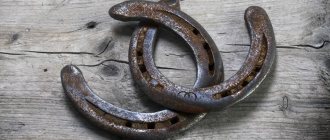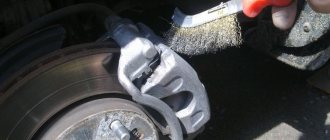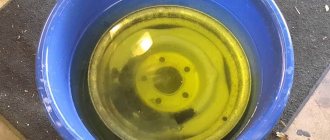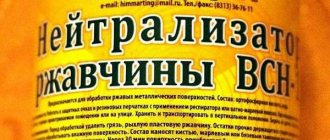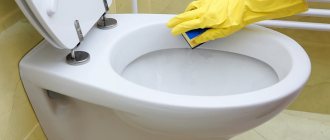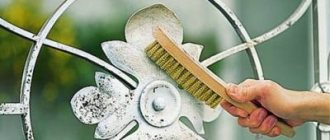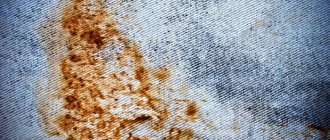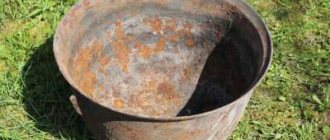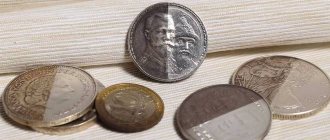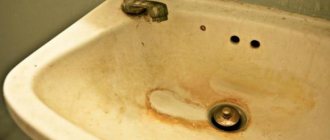The appearance of rust on metal surfaces and parts is a very common phenomenon that is often encountered not only by motorists. Corrosion is a chemical reaction that causes damage to metal. Cleaning rust from iron at home is one of the frequently asked questions that does not have a definite answer. In this material we will look at all possible ways to combat corrosion, and what tools, preparations and improvised means will be needed for this.
Rust on metal - causes of its occurrence
The first and very important question with which you need to start fighting corrosion involves finding out the cause of its occurrence. Having learned the reasons for the reaction, you can not only choose the optimal method for removing corrosion, but also prevent its reoccurrence.
Why does metal rust? The main reason for the reaction is the composition of the metal. It consists of various compounds such as oxygen, carbon, sulfur and others. It is these components that become the result of the appearance of rust stains on metal parts placed in water or a humid environment.
This is interesting! Pure metals do not rust, and these include gold, silver and platinum.
Metal in contact with air forms oxides, and with moisture - hydroxides. The effect of moisture and oxygen on metal contributes to its destruction, and the thinner the steel, the faster the process of its destruction occurs. This phenomenon is called corrosion, and the result of its occurrence is rust. It is almost impossible to avoid the occurrence of these processes, but various methods and techniques are used to reduce the rate of corrosion development.
Corrosion is a long-term process, so the destruction of metal products requires a long period of time, which directly depends on the thickness of the iron. It follows from this that the main reasons for the appearance of rust on metal are the following factors:
- Exposure of untreated metal to oxygen and moisture. In this case, the part does not necessarily have to be in a damp room. If you store a metal product in a dry and ventilated area, then signs of corrosion will also form after some time.
- Lack of special protective coatings - these include not only varnishes and paints, but also zinc coatings, which provide highly effective protection against the destructive effects of corrosion.
- Type of steel - high-alloy steels are susceptible to rusting with less intensity, which is due to the low percentage of carbon in the composition. However, such steels are quite expensive, so they are used for the manufacture of various high-precision parts or consumables for power tools.
Many people mistakenly believe that a type of steel such as stainless steel does not rust. We will not go into details of the composition of this material, but it is worth noting that even stainless steel is subject to the corrosion process. This is due, first of all, to the fact that the chrome film, which forms upon contact with oxygen, and thereby protects the metal from rust, is damaged, which ultimately leads to the appearance of rust.
To summarize, it should be noted that metal rusting is a normal natural phenomenon, which is a global problem for humans. And we are talking not only about problems with a rusting car body, but also about such global disasters as the sinking of ships, the destruction of bridges, etc., provoked by rusting metal.
How to wash clothes from rusty water
If laundry is washed in rusty water, it loses its original appearance - white fabrics acquire a reddish tint, and colored fabrics become dull. To wash clothes from rusty water, you can try several remedies:
- Before washing, put colored items in a basin with a solution of citric acid, white and light ones - soak in water with the addition of acetic and oxalic acid;
- During washing, add a stain remover to the powder, selected in accordance with the desired type of fabric.
Light-colored, rust-dyed items can also be soaked in bleach before washing.
Harm from rust or why you need to fight it
Everyone knows the danger of corrosion. In addition to the fact that the appearance of the metal part deteriorates, it also begins to lose its mechanical properties - strength, elasticity, rigidity, etc. Many people do not pay attention to the appearance of rust spots, which increase in size over time. The main danger of corrosion is that it corrodes the metal inside, making it ultimately unusable. As a result, you have to buy new parts, which causes additional costs.
The reasons for the need to combat rust are known. This must be done not only to protect the part from complete unsuitability, but also for aesthetic purposes. Moreover, the process of combating corrosion must be approached responsibly. An incorrect approach will only accelerate the rusting process, and in a short period of time it will fail.
Where does it come from?
Rust is the result of oxidation of iron-containing metals. She talks about metal erosion, its damage. In addition to being harmful to iron objects, rust has another negative property: it stains and, moreover, its traces are difficult to remove stains.
Such stains appear when the fabric comes into contact with metal objects that can rust and are either not coated with a protective layer or have damage to the coating:
- Unexpected rust stains can be caused by buttons, rivets, keys, hairpins, coins, paper clips or key rings left in the pocket;
- traces from swings, carousels and benches on children’s clothes have long become commonplace for parents;
- a rusty stain may appear as a result of drying the product on a heating radiator, especially a metal grill, ropes with a metal cable in the core - the integrity of their coating must be periodically checked.
If you remember the causes of pollution, then such troubles will happen to you much less often. But what to do if rust does settle? There are three options: throw the item away, take it to the dry cleaner, or try to remove the stain yourself. If you choose the third path, then many available tools that are in every home will become your assistants. Let's start rescuing clothes!
Cleaning metal from rust - special preparations and mechanical methods
To combat metal corrosion, there are three main methods - the use of chemical compounds, mechanical and electrochemical effects (processing). It is simply impossible to answer unequivocally the question of what is the best way to remove rust from metal. To understand why, let's look at the features of each method.
- The chemical method of combating corrosion has its advantages and disadvantages. The products are available in the form of formulations of various consistencies - liquids, gels and even sprays. They contain substances such as acids that come into contact with materials and effectively remove traces of corrosion. However, such preparations can only be used on surfaces of acid-resistant metals. If the metal is not acid-resistant, then substances containing inhibitors should be used to clean it. They remove rust without destroying the structure of the product.
- Mechanical methods - there are a large number of them, as well as drugs to combat corrosion. If in the first case the removal of corrosion stains occurs automatically due to a chemical reaction, then the mechanical method involves physical action. The most common method is to use sandpaper or files.
- Electrochemical - the principle of their operation is based on passing an electric current through a calcium solution. In this case, a reaction begins to occur, through which oxide ions move from the iron to the clean electrode. The method for removing corrosion in this way is called electrolysis, which is used in industry and household activities.
The advantage of the chemical method of combating corrosion is that there is no need to apply physical effort. Anyone who has dealt with rust removal knows how difficult it is to clean the surface to a shine by hand. However, the chemical method has some disadvantages that you should be aware of before choosing and using them:
- when using chemical reagents, you can remove not only rust, but also speed up the process of metal corrosion, which is especially important for steel less than 3-4 mm thick;
- When using reagents, it is important to use protective equipment, since the acids and alkalis contained in the composition can cause a chemical burn if they come into contact with human skin.
Chemicals are very effective, but it is important to use them with extreme caution. This is especially true when removing corrosion from a car body, where the slightest inaccuracy can lead to corrosion of the paintwork.
The mechanical method of removing corrosion, despite its main disadvantage in the form of significant time consumption, is more relevant and in demand. The main reason for its popularity is safety and effectiveness. Next, consider all kinds of ways that will help get rid of corrosion that has arisen on a metal surface.
Industrial products
Typically, household chemicals act quickly and reliably, are easy to use, and are widely available in any supermarket. However, you should be careful: not every type of fiber is suitable for such aggressive agents. Use chlorine-containing bleaches only on thick cotton or synthetic fabrics; avoid this substance when working with organza, silk, wool and other fragile materials.
What to do if rust has ruined a delicate item? For such cases, there are gentle industrial products - oxygen bleaches and stain removers. You will recognize them by the label “for delicate fabrics”. For colored items, purchase products marked accordingly.
Household chemicals to remove rust:
- Vanish is perhaps the most popular and effective product for removing various types of stains;
- Amway is an expensive product based on natural ingredients, but it does its job perfectly;
- “Antipyatin” - powder and soap that enhance the effect of the main detergent, suitable for children's clothes;
- Sarma - powder and laundry soap; according to customer reviews, these products not only clean stains, but also restore the white color of things;
- Ace oxi magic is a gentle stain remover for colored laundry.
How to properly remove rust stains using a stain remover:
- Gently apply a small amount using a brush or cotton pad.
- Leave for a short time (as written in the instructions, usually 10-15 minutes) so that the product penetrates into the fibers of the fabric.
- Wash the product with powder in warm water.
- Repeat if necessary.
Chemicals and traditional methods for effectively combating rust
Corrosion problems have been known for a very long time, and if now there are many different chemicals that can quickly and effectively remove rust stains, then previously improvised means were used instead. We will consider methods for removing corrosion using chemicals in more detail below.
Acetic acid is a cheap and effective drug
To quickly and cost-effectively remove rust from metal, you need to use 70% acetic acid or essence. You can also use regular vinegar. Fill the container with acid and place the part in it. After 2-3 hours, the workpiece can be removed from the container and the effectiveness of this drug can be verified.
Acetic acid can also be poured into a spray bottle, and thus treat a large surface. It is important to use safety glasses to prevent the drug from getting into your eyes. There is no need to talk about vinegar being 100% effective, but it all depends on the layer of rust on the part. After using this method, the workpiece should be thoroughly dried, and only then begin to apply additional protective agents.
Baking soda will help remove small pockets of corrosion on the metal surface.
Another product that is available in the kitchen is soda. It helps remove rust stains on metal surfaces. The principle of the procedure is to perform the following actions:
- Prepare a mixture by diluting soda with water and stirring thoroughly to obtain a porridge-like substance.
- Apply the resulting mixture to the area of rust formation and rub thoroughly using an unsuitable toothbrush.
- Wait a few hours, then rinse the surface thoroughly.
The procedure can be repeated several times to achieve an effective result. You can use soda not only to clean rust from kitchen utensils, but also from various parts.
Citric acid - removing rust in hard-to-reach places
Many have faced the need to remove metal corrosion in hard-to-reach places. If the outer surface can be sanded with sandpaper, then it is almost impossible to get into the internal cavities. In this case, a kitchen preparation such as citric acid will help.
In addition to effectively combating corrosion, citric acid is harmless to the skin of the hands, but in any case, it is recommended to use special gloves. The effectiveness of rust removal depends on the concentration of citric acid. It is recommended to dilute the powder with warm water in a proportion of 80 grams of acid per 100 ml of liquid. Next, the part is placed in a container with the solution for several hours, and after that it is removed.
Oxalic acid is a special preparation for fighting rust
Oxalic acid must be handled with care and with the obligatory use of protective equipment. The work algorithm involves performing the following actions:
- Pre-wash the part and dry it.
- Prepare a solution by dissolving six teaspoons of powder in 300 ml of water.
- Immerse the object in acid and remove it after half an hour.
- Remains of rust are removed with a toothbrush.
Acid copes not only with metal corrosion, but also with various surface contaminants.
Hydrochloric acid is a quick way to combat corrosion
To clean the surface of a metal product from rust, it is enough to treat it with a 2 percent solution of hydrochloric acid. When using this product, it is also important to follow safety precautions and use protective equipment.
Rust destroyers
You've probably come across drugs called rust destroyers or rust cleaners in hardware stores. They are liquid consistencies based on various acids that come into contact with metals.
The products are quite effective drugs, but they must be used carefully. They are not only dangerous to humans, but also to the hardware itself. Excessive amounts of acid will not only remove the corrosion, but also damage the metal.
In addition to destroyers, there are drugs such as converters. Their main difference from exterminators is that after treatment with such materials, the surface does not need further treatment with primer compounds. After the converter has dried, you can begin painting the surface.
Hydrogen peroxide - how effective is the drug?
If you need to remove rust from a bathtub, toilet bowl or cutlery, then you can use harmless hydrogen peroxide. The drug itself is not so effective, so it is recommended to use it together with trisodium phosphate. To prepare the product, you must perform the following steps:
- Dilute trisodium phosphate powder in 3 liters of water.
- Add 50 ml of hydrogen peroxide.
- Use the product to wet or wipe surfaces with traces of corrosion.
A popular drink such as Coca-Cola is also used to remove rust. This delicacy has this property due to the fact that it contains phosphoric acid. The process of removing corrosion with Coca-Cola takes a very long time (at least 20 hours), but the result cannot be pleasing to the eye.
This is interesting! In small quantities, the Coca-Cola drink is harmless to the body, but if it is consumed in large doses and constantly, one can imagine its negative impact on human organs.
An alternative to sandpaper is foil, which can be used to clean and remove minor rust on the metal surface. The methods listed above to combat corrosion are considered the best available means. However, to remove rust from important parts, you will need to use more significant methods.
Folk recipes
In addition to the above remedies for removing rust stains, there are several more very interesting folk methods.
Lemon acid
This recipe is suitable for both colored and white fabrics. Using citric acid in this case is very simple:
- 6 teaspoons of lemon must be diluted in a glass of water;
- heat the solution, but do not bring to a boil;
- place the contaminated area in the resulting composition and leave for 3-5 minutes;
- wash the item with powder.
Toothpaste
Dental fasting will help remove rust stains from white clothes, because this is perhaps the most accessible method of all. The principle of working with such a stain remover is simple: the paste is applied in a dense layer to the damaged area of the fabric and washed off after 1-2 hours.
Glycerol
Since the likelihood of spoiling the item is minimal, this method is quite gentle and is perfect for clothes made from fabrics that require careful handling or, for example, for usually expensive products - jackets, down jackets, curtains, car covers.
Expert opinion
The recipe is very simple: you need to mix glycerin, water and liquid soap in equal proportions. Apply the resulting composition to the problem area for at least 24 hours, then wash the product.
Bleach
The most common bleaches are chlorine-containing, for example, “Belizna”
However, you should use such products with caution, because they are only suitable for cotton fabrics and thick synthetic materials. Prolonged exposure to a solution containing chlorine can be harmful
Therefore, you need to apply bleach for a fairly short time - 10-15 minutes.
Chlorine-containing compounds can perfectly remove rust, as well as restore fabrics to their former whiteness. Such products are suitable for washing tulle and kitchen towels.
For products made of delicate materials, bleaches with a more gentle composition are suitable.
Mechanical methods of combating metal corrosion
How to remove rust from metal? The easiest way is to use sandpaper or a metal brush. The disadvantages of this method are known to everyone - the expenditure of effort and time, but even with these disadvantages, the method continues to remain relevant, and moreover, it is very popular.
To remove rust from metal surfaces mechanically, the following tools, consumables and devices are used:
- Hand brush for metal - the tool is a regular brush with a handle, but instead of the usual bristles it uses metal bristles. The wire-shaped bristles have varying stiffness, thereby ensuring their penetration into the smallest pores on the surface of the iron. Brushes are used to remove rust only in cases where there is a large layer of corrosion and dirt on the surface of the part. However, we can’t talk about 100% efficiency, since the brush removes only superficial deposits and is not able to clean out the orange deposits from the pores.
- Mechanical brushes (cord brushes) - the effectiveness of removing rusty deposits on the metal surface depends on the speed and frequency of passage of the bristles through the metal. Especially for such cases, special attachments for power tools have been developed - mechanical brushes for metal. The products are available in different shapes, types and configurations, which allows you to use the best option for cleaning various surfaces. The brushes are suitable for electric drills and angle grinders. Despite the simplicity of the design of the nozzles, it is quite difficult to work with them due to centrifugal force. When the nozzle touches the surface being treated, the tool tends to escape from your hands, so it is very important to hold it with both hands. When working, you need to use protective equipment, which is due to the formation of large amounts of metal dust. In addition, the separation of lint cannot be ruled out, which, at high rotation speeds of the nozzle, can get stuck in the skin. To eliminate such consequences, it is recommended to carry out work in special clothing. The bristles on the brushes can be coated with a layer of brass. This is done so that during the cleaning process a protective brass film is created on the treated area.
- Sandpaper – You can remove rust using sandpaper. This is one of the most effective means, the main advantage of which is the ability to select fractions of suitable size. Sandpaper should be selected depending on the size of the pores present on the workpiece. The disadvantage of using sandpaper is that the process is complicated and time-consuming.
- Power Tools for Sandpaper - To remove corrosion from metal using sandpaper, it is recommended to use power tools. These include drills, grinders and grinders. Special round attachments are designed for fastening in the chuck of a drill (screwdriver) or the spindle of an angle grinder. Sanding sheets are used on sanding machines. The downside to using power tools with sandpaper is that you have limited access to tight spots. And therefore, especially for such cases, a type of tool such as a sandblasting gun was invented.
- Sandblasting gun or sandblasting equipment - the products have a simple design, but their main advantage is the high quality of rust removal. The operating principle of the equipment is based on cleaning the surface using grains of sand. Sand flies out of the nozzle of a special nozzle, called a gun, under the influence of compressed air pressure. Due to the high air pressure, the speed at which grains of sand fly out increases, which, when they hit the surface, clean the rust. Today, sandblasting equipment is the most effective means for high-quality cleaning of metal surfaces from rust.
Knowing what mechanical methods exist to remove corrosion from metal, it will not be difficult to choose the appropriate option or try all methods. It is important to note that when using sandblasting equipment it is important to consider the following:
- The devices have high power, so it is not recommended to use them for processing thin sheet metal.
- Sandblasting machines can easily cope not only with rust, but also with cleaning the surface of dirt and paintwork.
- The efficiency of the equipment depends on the type of sand used - river, quartz, corundum, etc.
Moreover, it is important to understand that the installations effectively remove rust not only in open areas, but also in hard-to-reach places. To reliably and effectively combat rust formed on metal, it is recommended to give preference to sandblasting machines.
Electrochemical method of rust removal using the example of a car body
Particular attention should be paid to such a method of combating corrosion as the electrochemical method. It is immediately worth noting that this method is suitable for combating corrosion on any type of metal surfaces, including car bodies.
The essence of this method is based on provoking electrochemical corrosion. Metal conducts electric current, and depending on its magnitude and voltage potential, atoms are aligned in a certain chemical series.
The electrochemical corrosion removal method is also called cathodic protection. Why protection? This method allows not only to remove corrosion, but also to apply a protective zinc film to the metal. All this can be done at home. And if the method of removing corrosion using sandblasting equipment does not suit you, then we will consider in detail how you can eliminate corrosion on a car body using the electrolytic method.
Initially, you need to prepare the necessary tools and materials. For this you will need:
- DC source. You can use a car battery, but it is recommended to use a charger with current and voltage indicators, as well as a step regulator.
- A container made of material that does not conduct current. This is in case you plan to process the removed part.
- Aqueous solution - it is recommended to use baking soda or soda ash as the medium in which the reaction will occur. An alternative is a pipe cleaner called "Mole". It contains sodium.
- The positive electrode acts as an anode. It is recommended to use stainless steel material as an electrode. The metal used must be a conductor of current, but only with less conductivity than the metal being processed.
- To ensure the procedure is carried out correctly, you will need one more important detail - a fabric insert on the anode. It not only eliminates the occurrence of a short circuit, but also allows you to apply an aqueous solution to the area that needs to remove corrosion.
As you can see, every home craftsman has all the necessary materials and tools in his arsenal. After preparing the necessary tools, we move on to creating a tool for electrolytic cleaning of metal from corrosion.
- Initially, it is necessary to attach an electrode to the positive contact (terminal) from the charger or car battery. As an alternative, we use a stainless steel spoon.
- Next, a woven material must be wound around the electrode attached to the positive terminal. You can use a sponge or any cloth. The reaction speed depends on the thickness of the fabric, and the thicker it is, the slower the anodizing process.
- The tool for removing rust from a car body is almost ready for use. All that remains is to secure the negative terminal from the charger to the car body. If a battery is used, then the “ground” is already on the car, and you can begin to manipulate it.
- Prepare an aqueous solution using the “Mole” product. To speed up the process, you can add soda ash or sodium to the solution. If you use regular soda, then 1 tablespoon per 1 liter of water is enough.
- By wetting the anode sponge, we treat the area on the car body with signs of corrosion. It is very important to pre-clean this area of contamination. The saffron caps should also be cleaned of paintwork to ensure that corrosion in these areas is removed.
- Before starting the procedure, connect the charger to the network and set the current. The current strength depends on the size of the part, so we proceed as follows. If saffron milk caps are removed, as shown in the photo above, then we set the current to 6-8 Amperes. It will be quite enough. If you need to clean a large part from corrosion, for example, a car wheel, then you will need a larger current, 10-15A. However, it is important not to overdo it here, since this way you can burn the memory.
- Let's get down to business - wet the woven part of the anode in the solution, and clean the area on the car with signs of corrosion. In just a few minutes you can see how the rust begins to dissolve.
- After thorough treatment, it is necessary to rinse the treated area with distilled water. Using plain water with a salt solution will worsen the situation.
- After cleaning the rust on the car body, you can proceed to the next stage - protecting it with galvanizing and painting.
To galvanize a car body at home, a similar tool is used. The only difference is that instead of a stainless electrode it is necessary to use a zinc plate. In order for zinc ions to transfer to the metal and create a protective film, it is necessary to treat the fabric in which the anode is wrapped with soldering acid.
Naturally, the method of electrochemical removal of corrosion from metal is suitable for untreated cases (for example, a car body). The thickness of a car body is 2-3 mm, and if the metal is completely rotten, then there is no point in trying to clean it or save it in any way. In this case, you will need to replace the failed body part. In order not to have to change part of the car body, it is recommended that when the first saffron milk caps are detected, resort to rust removal.
This is interesting! It is important to understand that although saffron milk caps appear on cars on the outside, the reason for their occurrence is hidden inside. In this case, after removing the saffron cap on the outer part, do not forget to check the inside of the part. There is a high probability that the corrosion stain will be more significant on the inside than on the outside.
You don't have to be a chemist to clean rust from metal using the electrochemical method. The procedure is extremely simple and understandable, however, when implementing it, it is important to follow safety precautions and use personal protective equipment (PPE). Below is a video that describes in detail the process of how to remove rust on a car body quickly, efficiently and efficiently.
Removing stains from colored fabrics
There is no universal recipe for cleaning colored clothes from rust stains. You will have to test the selected methods on inconspicuous areas of a particular fabric to make sure that the color pigment is not washed out.
Chalk and glycerin paste
There are 2 ways to remove rust from colored clothing using a mixture of chalk and glycerin. For 1 recipe you will need:
- Mix chalk powder with glycerin to obtain a thick paste. Add a couple of drops of warm water until the consistency becomes a homogeneous paste.
- Rub the mixture onto the stain and wait until it dries.
- Afterwards, wash the treated area by hand, and then put the item in the machine.
The next method will take a little more time:
- The product is washed on a regular program with the addition of fabric softener and dried.
- Prepare a mixture of 50 g of chalk powder, 50 ml of glycerin and 30 ml of water. Distribute it over areas stained with rust.
- Place clothes in a plastic bag at night. Then it is dried again and then washed with laundry soap.
Laser cleaning of metal from corrosion
In addition to the methods described above, there is another method of combating metal corrosion. It involves the use of laser equipment. This is a modern technology that is characterized by high speed, quality and efficiency. It has only one drawback - its high cost, so not everyone can afford to use it. Due to the high cost of the method, it is used to clean precious metals from corrosion and plaque.
The advantages of this method include the following factors:
- no release of harmful substances;
- automatic shutdown of the laser beam;
- ability to work with combined materials;
- high speed and quality;
- no need to replace consumables.
The cleaning procedure involves applying laser radiation to areas that need to be cleaned from corrosion. The laser beam acts exclusively on contaminated surfaces. The beam is reflected from clean areas, and damaged areas are heated, thereby removing plaque from them.
During laser exposure, heating causes a transformation of the structure, which ultimately causes plaque exfoliation. As the power of the equipment increases, the process of plaque evaporation occurs. The equipment is capable of heating workpieces to a temperature of 16.5 thousand degrees Celsius. The cleaning process is performed automatically. Initially, the working surface is scanned, and then the focused beam processes the part.
This is interesting! The use of such equipment for home use is irrational due to its high cost.
Citric acid against dirt
The method described below can rightfully be considered one of the most effective in the fight against traces of rust.
1 Dilute a packet of citric acid in a quarter glass of warm water or squeeze a small amount of lemon juice.
2Moisten the stain generously with an acidic solution and turn the item inside out.
3Spread a clean white cloth on the ironing board and place the soiled item of clothing on it.
4 Cover the top of the item with a white cloth as well.
5 Heat the iron, turn on the steam function and iron the contaminated item, paying special attention to the contaminated area. The stain particles should transfer into the fabric.
6Rub the stain with your hands using laundry soap and wash the item as usual.. If the stain is fresh, you can wrap the pulp of half a lemon in gauze, run this bag over the stain, and then iron the treated area
If the stain is fresh, you can wrap the pulp of half a lemon in gauze, run this bag over the stain, and then iron the treated area.
A high temperature for treating stains can also be achieved by boiling. However, this method is not suitable for removing stains from delicate fabrics.
Preventive actions
To protect iron from rust, various alloys are used. These include chromium, molybdenum, nickel, sulfur, etc. The disadvantage of these methods is their high cost. A cheaper and more practical means of protecting steel is to coat it with various materials that create a barrier between the surface of the product and the environment. As such coatings, not only varnishes and paints are used, but also coatings made of zinc, chromium, tin, copper and nickel.
Using zinc as a protective layer is not only the most common, but also an effective method. The corrosion process of zinc occurs very slowly, and if applied correctly, the metal part will last at least 20-30 years. If a part has become rusty, its service life can be extended with timely treatment.
To summarize the above, it should be noted that metal corrosion is a normal phenomenon for nature, but abnormal for humans. A person cannot exclude the development of such processes, but it is quite possible to stop them if they choose the right method for removing rust.
